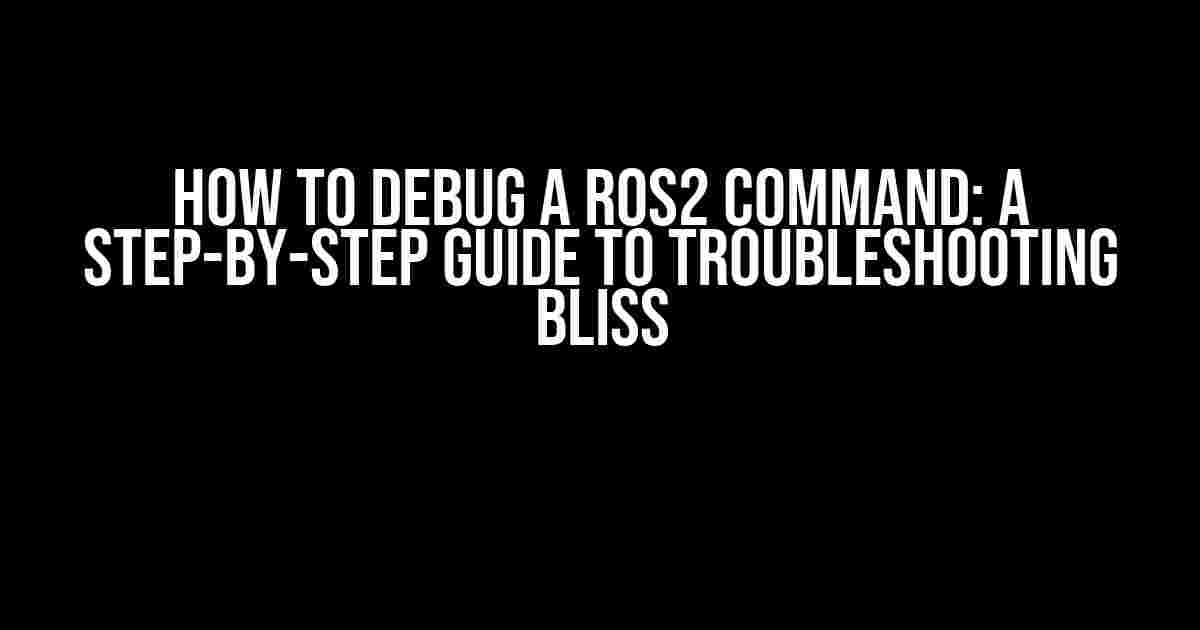Are you tired of banging your head against the wall, trying to figure out why your ROS2 command isn’t working as expected? Do you feel like you’ve tried every possible solution, but still, your code refuses to cooperate? Well, fear not, dear ROS enthusiast! This article is here to guide you through the mystical realm of debugging, and by the end of it, you’ll be a master troubleshooter, equipped with the skills to tackle even the most stubborn ROS2 command errors.
What is Debugging, and Why Do I Need It?
Debugging is the process of identifying and fixing errors or bugs in your code. In the context of ROS2, it’s an essential skill to master, as it helps you pinpoint and resolve issues that might be causing your commands to malfunction. Think of debugging as a detective’s toolkit – you need it to uncover the clues that will lead you to the solution.
Common ROS2 Command Errors
Before we dive into the nitty-gritty of debugging, let’s take a look at some common ROS2 command errors that might be driving you crazy:
- Command not running or producing unexpected results
- Nodes not communicating with each other
- Titles not being published or subscribed
- Services not being called or returning errors
- Actions not being executed or failing
These errors can be frustrating, but don’t worry, we’ll get to the bottom of them!
Step 1: Check Your Command Syntax
The first step in debugging a ROS2 command is to ensure that your syntax is correct. Yeah, we know, it sounds obvious, but trust us, it’s easy to overlook a simple typo or misplaced bracket. Take a closer look at your command and check for any of the following:
- Typos in node names, topic names, or command options
- Incorrect use of quotes, brackets, or parentheses
- Mismatched or missing argument types
- Incorrect use of ROS2 command-line tools (e.g., `ros2 topic` instead of `ros2 topic list`)
Use the ROS2 documentation and online resources to double-check your syntax. If you’re still unsure, try breaking down your command into smaller parts and testing each component individually.
Step 2: Verify Your ROS2 Environment
Now that we’ve ruled out syntax errors, let’s make sure your ROS2 environment is set up correctly. Here are some things to check:
- Is your ROS2 version compatible with the command you’re trying to run?
- Have you sourced the ROS2 setup file (e.g., `source /opt/ros/foxy/setup.bash`)?
- Are you using the correct ROS2 distribution (e.g., Foxy, Galactic, or Humble)?
- Have you checked for any environment variable conflicts?
Take a moment to review your ROS2 setup and ensure that everything is in order. If you’re still stuck, try resetting your environment or seeking help from the ROS community.
Step 3: Use ROS2 Command-Line Tools
ROS2 provides a range of command-line tools that can help you debug your commands. Let’s explore some of the most useful ones:
ros2 node
Use `ros2 node` to list, inspect, or kill nodes. This can help you identify issues with node communication or execution:
$ ros2 node list $ ros2 node info$ ros2 node kill
ros2 topic
Use `ros2 topic` to inspect, publish, or subscribe to topics. This can help you diagnose issues with topic publishing or subscription:
$ ros2 topic list $ ros2 topic info$ ros2 topic pub $ ros2 topic sub
ros2 service
Use `ros2 service` to list, call, or inspect services. This can help you troubleshoot issues with service calls or responses:
$ ros2 service list $ ros2 service info$ ros2 service call
ros2 action
Use `ros2 action` to list, inspect, or cancel actions. This can help you diagnose issues with action execution or feedback:
$ ros2 action list $ ros2 action info$ ros2 action cancel
These command-line tools can provide valuable insights into what’s going on behind the scenes. Make sure to explore each one thoroughly to identify potential issues.
Step 4: Review Your ROS2 Logs
ROS2 logs can be a treasure trove of information when it comes to debugging. By default, ROS2 logs are stored in the `~/.ros/log` directory. You can use tools like `ros2 log` to inspect and filter log messages:
$ ros2 log $ ros2 log filter
Pay attention to error messages, warnings, and informational logs that might indicate issues with your command or environment. You can also use third-party log analysis tools to help you visualize and understand your log data.
Step 5: Consult Online Resources and Communities
If you’ve reached this point and still can’t figure out what’s going on, don’t worry! There are plenty of online resources and communities that can help:
- The official ROS2 documentation and tutorials
- The ROS community forum and Q&A platform
- ROS-related subreddits and online forums
- GitHub issues and pull requests related to ROS2
Don’t be afraid to ask for help or share your issue with the community. Chances are, someone has faced a similar problem before, and you can learn from their experience.
Conclusion
Debugging a ROS2 command can be a daunting task, but by following these steps, you’ll be well on your way to troubleshooting like a pro. Remember to:
- Check your command syntax
- Verify your ROS2 environment
- Use ROS2 command-line tools
- Review your ROS2 logs
- Consult online resources and communities
With patience, persistence, and practice, you’ll become a master debugger, equipped to tackle even the most challenging ROS2 command errors. Happy debugging!
| Debugging Step | Description |
|---|---|
| 1. Check Command Syntax | Verify command syntax and options |
| 2. Verify ROS2 Environment | Check ROS2 version, setup, and environment variables |
| 3. Use ROS2 Command-Line Tools | Utilize `ros2 node`, `ros2 topic`, `ros2 service`, and `ros2 action` tools |
| 4. Review ROS2 Logs | Inspect and filter log messages for errors and warnings |
| 5. Consult Online Resources | Seek help from ROS community, documentation, and online forums |
Frequently Asked Question
Debugging ROS2 commands can be a daunting task, but fear not! We’ve got you covered with these frequently asked questions and answers to help you troubleshoot like a pro!
Q1: Where do I start debugging my ROS2 command?
When debugging a ROS2 command, start by checking the ROS2 terminal output for any error messages. Look for keywords like “Error”, “Exception”, or “Warning” to identify the source of the issue. You can also use the `ros2 command -h` flag to see the help menu and understand the available options and syntax.
Q2: How can I enable verbose logging in ROS2?
To enable verbose logging in ROS2, you can use the `–verbose` flag followed by the logging level (e.g., `–verbose DEBUG`). This will provide more detailed logs to help you identify the issue. You can also set the `ROS_CONSOLE_FORMAT` environment variable to change the logging format.
Q3: What are some common ROS2 debugging tools?
Some popular ROS2 debugging tools include `ros2 topic list`, `ros2 topic echo`, `ros2 node list`, and `ros2 node info`. These tools help you inspect and debug your ROS2 nodes, topics, and services. You can also use third-party tools like `ros2-bag` to record and replay ROS2 data.
Q4: How can I debug a ROS2 launch file?
To debug a ROS2 launch file, use the `ros2 launch` command with the `–introspect` flag to see the launch file’s internal state. You can also add `print` statements or use a debugger like `gdb` to step through the launch file’s execution. Additionally, check the launch file’s syntax using `ros2 launch –check`.
Q5: Where can I find more resources for debugging ROS2 commands?
The ROS2 documentation is a great place to start, with tutorials and guides on debugging and troubleshooting. You can also search for answers on the ROS2 community forum, Reddit’s r/ROS, or Stack Overflow. Don’t forget to check out the ROS2 GitHub issues and wiki pages for more information and resources!


